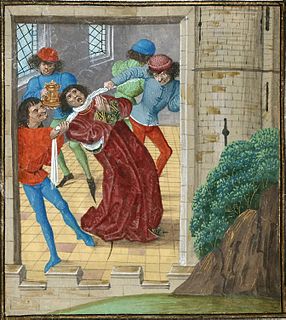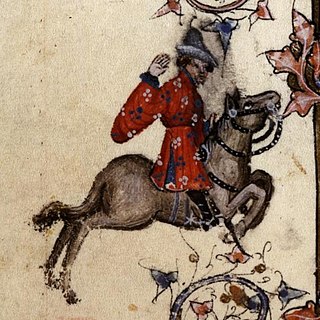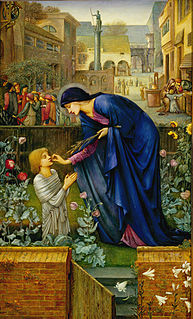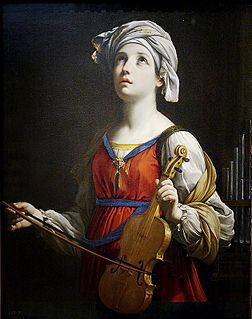 W
WThe Canterbury Tales is a collection of 24 stories that runs to over 17,000 lines written in Middle English by Geoffrey Chaucer between 1387 and 1400. In 1386, Chaucer became Controller of Customs and Justice of the Peace and, in 1389, Clerk of the King's Works. It was during these years that Chaucer began working on his most famous text, The Canterbury Tales. The tales are presented as part of a story-telling contest by a group of pilgrims as they travel together from London to Canterbury to visit the shrine of Saint Thomas Becket at Canterbury Cathedral. The prize for this contest is a free meal at the Tabard Inn at Southwark on their return.
 W
W"The Canon's Yeoman's Tale" is one of The Canterbury Tales by Geoffrey Chaucer.
 W
WGeoffrey Chaucer was an English poet and author. Widely considered the greatest English poet of the Middle Ages, he is best known for The Canterbury Tales. He has been called the "father of English literature", or, alternatively, the "father of English poetry". He was the first writer to be buried in what has since come to be called Poets' Corner, in Westminster Abbey. Chaucer also gained fame as a philosopher and astronomer, composing the scientific A Treatise on the Astrolabe for his 10-year-old son Lewis. He maintained a career in the civil service as a bureaucrat, courtier, diplomat, and member of parliament.
 W
WSir Thopas is one of The Canterbury Tales by Geoffrey Chaucer, published in 1387. The tale is one of two—together with The Tale of Melibee—told by the fictive Geoffrey Chaucer as he travels with the pilgrims on the journey to Canterbury Cathedral. The tale concerns the adventures of the knight "Sir Thopas" and his quest to win the elf-queen.
 W
W"The Clerk's Tale" is the first tale of Group E in Geoffrey Chaucer's The Canterbury Tales. It is preceded by The Summoner's Tale and followed by The Merchant's Tale. The Clerk of Oxenford is a student of what would nowadays be considered philosophy or theology. He tells the tale of Griselda, a young woman whose husband tests her loyalty in a series of cruel torments that recall the biblical Book of Job.
 W
WSir Nicholas Colfox was a medieval English knight who in 1397 was involved in the murder of Thomas of Woodstock, 1st Duke of Gloucester, uncle of King Richard II, apparently on the orders of the king. Colfox's involvement in the killing may have been alluded to in Geoffrey Chaucer's Nun's Priest's Tale, in which a duplicitous fox is referred to as a "Colfox" and described as "liking to murder men".
 W
WA Commentary on the General Prologue to The Canterbury Tales is a 1948 doctoral dissertation by Muriel Bowden that examines historical backgrounds to characters in Geoffrey Chaucer's The Canterbury Tales within the context of its General Prologue.
 W
WGeoffrey Chaucer presumably never finished "The Cook's Tale" and it breaks off after 58 lines, although some scholars argue that Chaucer deliberately left the tale unfinished. The story starts telling of an apprentice named Perkyn who is fond of drinking and dancing. Perkyn is released by his master and moves in with a friend who also loves to drink, and whose wife is a shopkeeper whose real occupation is that of a prostitute.
 W
WThe Ellesmere Chaucer, or Ellesmere Manuscript of the Canterbury Tales, is an early 15th-century illuminated manuscript of Geoffrey Chaucer's Canterbury Tales, owned by the Huntington Library, in San Marino, California. It is considered one of the most significant copies of the Tales.
 W
W"The Franklin's Tale" is one of The Canterbury Tales by Geoffrey Chaucer. It focuses on issues of providence, truth, generosity and gentillesse in human relationships.
 W
W"The Friar's Tale" is a story in The Canterbury Tales by Geoffrey Chaucer, told by Huberd the Friar. The story centers around a corrupt summoner and his interactions with the Devil. It is preceded by The Wife of Bath's Tale and followed by The Summoner's Tale.
 W
WThe General Prologue is the first part of The Canterbury Tales by Geoffrey Chaucer.
 W
WThe Host is a character who plays a key role in and throughout Geoffrey Chaucer's The Canterbury Tales. He is the owner of the Tabard Inn in London, where the pilgrimage begins and he agrees to travel on the pilgrimage, and promises to judge both the tales the pilgrims tell, and disputes among the pilgrims. He discusses his marriage to his absent wife, Goodelief when commenting on The Tale of Melibee with its message of patience. The Host says Goodelief is herself extremely impatient and speedy in urging him to violent revenge. Her name Goodelief may be a real name or just meaning, perhaps ironically, good dear one.
 W
WContact between Geoffrey Chaucer and the Italian humanists Petrarch or Boccaccio has been proposed by scholars for centuries. More recent scholarship tends to discount these earlier speculations because of lack of evidence. As Leonard Koff remarks, the story of their meeting is "a 'tydying' worthy of Chaucer himself".
 W
W"The Knight's Tale" is the first tale from Geoffrey Chaucer's The Canterbury Tales.
 W
W"The Man of Law's Tale" is the fifth of the Canterbury Tales by Geoffrey Chaucer, written around 1387. John Gower's "Tale of Constance" in Confessio Amantis tells the same story and may have been a source for Chaucer. Nicholas Trivet's Les chronicles was a source for both authors.
 W
W"The Manciple's Tale" is part of Geoffrey Chaucer's The Canterbury Tales. It tends to appear near the end of most manuscripts of the poem, and the prologue to the final tale, "The Parson's Tale", makes it clear it was intended as the penultimate story in the collection. The Manciple, a purchasing agent for a law court, tells a fable about Phoebus Apollo and his pet crow, which is both an etiological myth explaining the crow's black feathers, and a moralistic injunction against gossip.
 W
W"The Merchant's Tale" is one of Geoffrey Chaucer's Canterbury Tales. In it Chaucer subtly mocks antifeminist literature like that of Theophrastus ("Theofraste"). The tale also shows the influence of Boccaccio, Deschamps' Le Miroir de Mariage, Roman de la Rose by Guillaume de Lorris, Andreas Capellanus, Statius, and Cato. The tale is found in Persia in the Bahar Danush, in which the husband climbs a date tree instead of a pear tree. It could have arrived in Europe through the One Thousand and One Nights, or perhaps the version in book VI of the Masnavi by Rumi. Though several of the tales are sexually explicit by modern standards, this one is especially so. Larry Benson remarks:The central episode of the Merchant's Tale is like a fabliau, though of a very unusual sort: It is cast in the high style, and some of the scenes are among Chaucer's most elaborate displays of rhetorical art.
 W
W"The Miller's Tale" is the second of Geoffrey Chaucer's Canterbury Tales (1380s–1390s), told by the drunken miller Robin to "quite" "The Knight's Tale". The Miller's Prologue is the first "quite" that occurs in the tales.
 W
W"The Monk's Tale" is one of The Canterbury Tales by Geoffrey Chaucer.
 W
W"The Nun's Priest's Tale" is one of The Canterbury Tales by the Middle English poet Geoffrey Chaucer. Composed in the 1390s, it is a beast fable and mock epic based on an incident in the Reynard cycle. The story of Chanticleer and the Fox became further popularised in Britain through this means.
 W
W"The Pardoner's Tale" is one of The Canterbury Tales by Geoffrey Chaucer. In the order of the Tales, it comes after The Physician's Tale and before The Shipman's Tale; it is prompted by the Host's desire to hear something positive after that depressing tale. The Pardoner initiates his Prologue—briefly accounting his methods of swindling people—and then proceeds to tell a moral tale.
 W
W"The Parson's Tale" seems, from the evidence of its prologue, to have been intended as the final tale of Geoffrey Chaucer's poetic cycle The Canterbury Tales. The "tale", which is the longest of all the surviving contributions by Chaucer's pilgrims, is in fact neither a story nor a poem, but a long and unrelieved prose treatise on penance. Critics and readers are generally unclear what rhetorical effect Chaucer may have intended by ending his cycle in this unlikely, extra-generic fashion.
 W
W"The Physician's Tale" is one of The Canterbury Tales, written by Geoffrey Chaucer in the 14th century.
 W
WPierce the Ploughman's Crede is a medieval alliterative poem of 855 lines, lampooning the four orders of friars.
 W
W"The Prioress's Tale" follows "The Shipman's Tale" in Geoffrey Chaucer's The Canterbury Tales. Because of fragmentation of the manuscripts, it is impossible to tell where it comes in ordinal sequence, but it is second in group B2, followed by Chaucer's Tale of Sir Topas. The General Prologue names the prioress as Madame Eglantine, and describes her impeccable table manners and soft-hearted ways. Her portrait suggests she is likely in religious life as a means of social advancement, given her aristocratic manners and mispronounced French. She maintains a secular lifestyle, including keeping lap dogs that she privileges over people, a fancy rosary and brooch inscribed with "Amor vincit omnia".
 W
W"The Reeve's Tale" is the third story told in Geoffrey Chaucer's The Canterbury Tales. The reeve, named Oswald in the text, is the manager of a large estate who reaped incredible profits for his master and himself. He is described in the Tales as skinny and bad-tempered and old; his hair is closely cropped reflecting his social status as a serf. His sword is rusty while he rides a fine gray horse called Scot. The Reeve is a skilled carpenter, a profession mocked in the previous "Miller's Tale". Oswald responds with a tale that mocks the Miller's profession.
 W
W"The Second Nun's Tale", written in late Middle English, is part of Geoffrey Chaucer's The Canterbury Tales. Narrated by a nun who remains unnamed, it is a hagiography of the life of Saint Cecilia.
 W
W"The Shipman's Tale" is one of The Canterbury Tales by Geoffrey Chaucer.
 W
WThe Squire is a fictional character in the framing narrative of Geoffrey Chaucer's Canterbury Tales. He is squire to the Knight and is the narrator of The Squire's Tale or Cambuscan. The Squire is one of the secular pilgrims, of the military group. The Knight and the Squire are the pilgrims with the highest social status. However his tale, interrupted as it is, is paired with that of the Franklin. The Squire is a candidate for the interrupter of The Host in the epilogue of the Man of Law's Tale.
 W
W"The Squire's Tale" is a tale in Geoffrey Chaucer's The Canterbury Tales. It is unfinished, perhaps deliberately, and comes first in group F, followed by the Franklin's interruption, prologue and tale. The Squire is the Knight's son, a novice warrior and lover with more enthusiasm than experience. His tale is an epic romance, which, if completed, would probably have been longer than rest of the Tales combined. It contains many literary allusions and a great deal of vivid description.
 W
W"The Wife of Bath's Tale" is among the best-known of Geoffrey Chaucer's Canterbury Tales. It provides insight into the role of women in the Late Middle Ages and was probably of interest to Chaucer himself, for the character is one of his most developed ones, with her Prologue twice as long as her Tale. He also goes so far as to describe two sets of clothing for her in his General Prologue. She holds her own among the bickering pilgrims, and evidence in the manuscripts suggests that although she was first assigned a different, plainer tale—perhaps the one told by the Shipman—she received her present tale as her significance increased. She calls herself both Alyson and Alys in the prologue, but to confuse matters these are also the names of her 'gossib', whom she mentions several times, as well as many female characters throughout The Canterbury Tales.